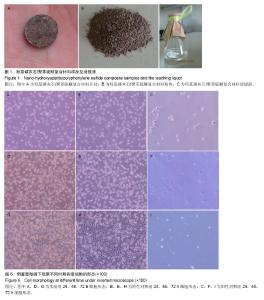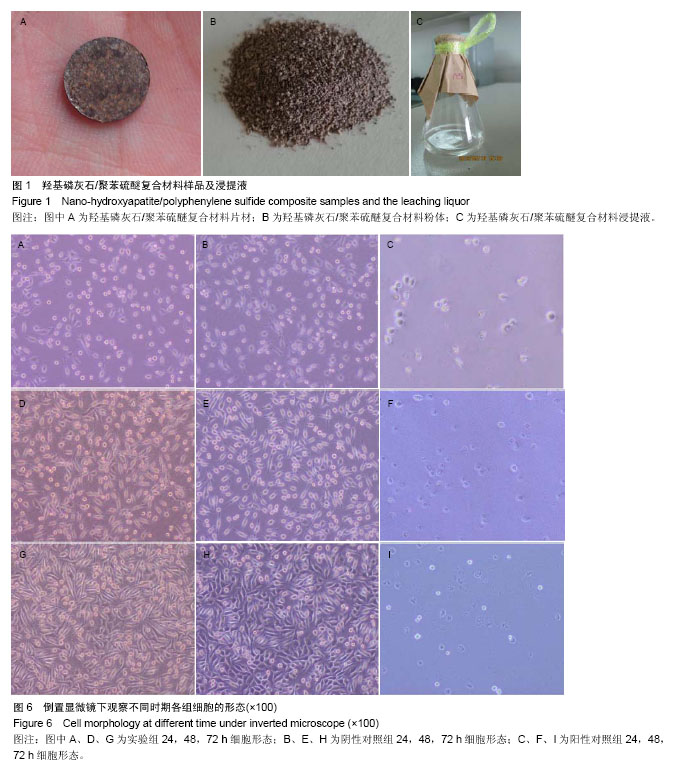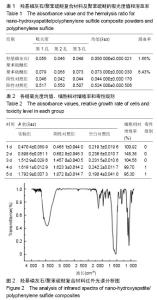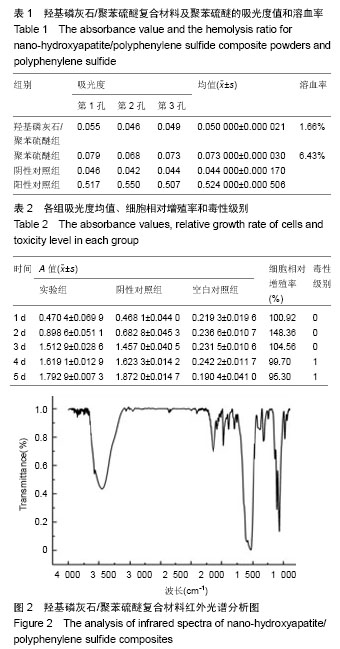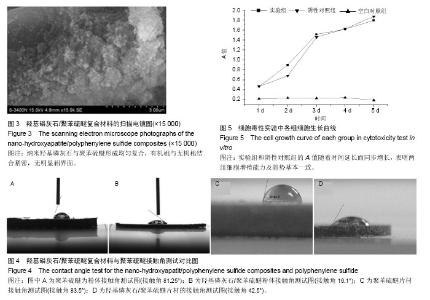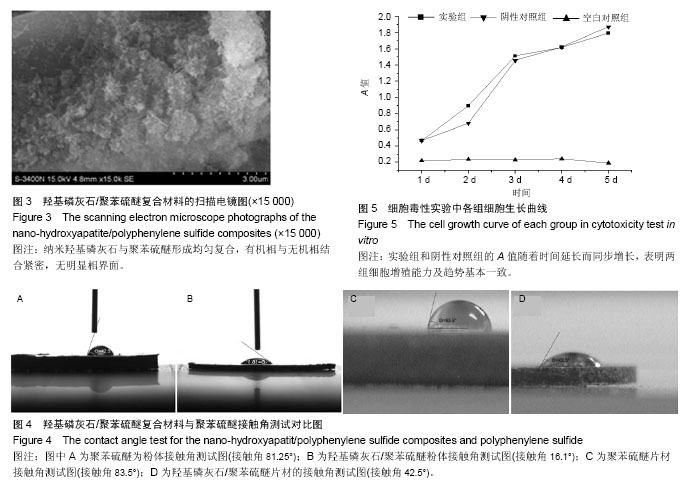| [1] 徐国财,张立德.纳米复合材料[M].北京:化学工业出版社, 2002: 11-24.
[2] Sepulveda P,Bressiani AH,Bressiani JC,et al.In vivo evaluation of hydroxyapatite foams.J Biomed Mater Res. 2002;2(4):587-592.
[3] Wang X,Li Y,Wei J,et al.Development of biomimetic nanohydroxyapatite/poly(hexamethylene adipamide) composites. Biomaterials.2002;23(24):4787-4791.
[4] 叶金凤,陈庆华,张峰,等.共滴定法制备纳米羟基磷灰石/甲壳素复合材料[J].中国陶瓷,2007,43(8):18-20.
[5] Li S,Huang B,Chen Y,et al.Hydroxyapatite-coated femoral stems in primary total hip arthroplasty: a meta-analysis of randomized controlled trials. Int J Surg.2013;11(6):477-482.
[6] Oonishi H.A long term histological analysis of effect of interposed hydroxyapatite between bone and bone cement in THA and TKA.J Long Term Eff Med Implants.2012;22(2): 165-176.
[7] Munzinger U,Guggi T,Kaptein B,et al.A titanium plasma-sprayed cup with and without hydroxyapatite-coating: a randomised radiostereometric study of stability and osseointegration.Hip Int.2013;23(1):33-39.
[8] Cossetto DJ.Mid-term outcome of a modular, cementless, proximally hydroxyapatite-coated, anatomic femoral stem.J Orthop Surg.2012;20(3):322-326.
[9] Herrera A,Mateo J,Lobo-Escolar A,et al.Long-term outcomes of a new model of anatomical hydroxyapatite-coated hip prosthesis.J Arthroplasty. 2013;28(7):1160-1166.
[10] Eschen J,Kring S,Brix M,et al.Outcome of an uncemented hydroxyapatite coated hemiarthroplasty for displaced femoral neck fractures: a clinical and radiographic 2-year follow-up study.Hip Int.2012;22(5):574-579.
[11] Lazarinis S,K?rrholm J,Hailer NP.Effects of hydroxyapatite coating of cups used in hip revision arthroplasty.Acta Orthop. 2012;83(5):427-435.
[12] Melton JT,Mayahi R,Baxter SE,et al.Long-term outcome in an uncemented, hydroxyapatite-coated total knee replacement:a 15-to 18-year survivorship analysis.J Bone Joint Surg Br. 2012; 94(8):1067-1070.
[13] Chris Arts JJ,Verdonschot N,Schreurs BW,et al.The use of a bioresorbable nano-crystalline hydroxyapatite paste in acetabular bone impaction grafting. Biomaterials. 2006;27(7): 1110-1118.
[14] 李志宏,武继民,李瑞欣,等.纳米羟基磷灰石及其复合材料的研究进展[J].医疗卫生装备,2007,28(04):30-31
[15] 李宝强,胡巧玲,汪茫,等.原位复合法制备层状结构的壳聚糖/羟基磷灰石纳米材料[J].高等学校化学学报,2004,25(10):1949-1952.
[16] 许凤兰,李玉宝,姚晓明,等.纳米羟基磷灰石/聚乙烯醇复合人工角膜材料[J].复合材料学报,2005,22(1):27-31.
[17] 王群波,蒋电明,安洪,等.纳米羟基磷灰石/聚酰胺66复合人工椎体在胸腰椎骨折中的应用[J].中国创伤杂志,2005,21(9):690-692.
[18] 赵俊亮,付涛,魏建华,等.羟基磷灰石/环氧树脂复合材料的制备与性能[J].生物医学工程学杂志,2005,22(2):238-241.
[19] 李亚军,阮建明.聚乳酸/羟基磷灰石复合型多孔状可降解生物材料[J].中南工业大学学报,2002,33(3):261-265.
[20] 郝和平.医疗器械生物学评价标准实施指南[M].北京:中国标准出版社,2000.
[21] 刁云锋,杨细平.几种颅骨修补材料的临床应用及并发症防治[J].中国组织工程研究与临床康复,2011,4(16):2985-2989.
[22] 曹胜武,刘宁,赵春生,等.计算机塑型医用树脂和羟基磷灰石复合材料与手工塑型钛网修补大面积颅骨缺损的比较[J].中国组织工程研究与临床康复,2009,13(34):6701-6704.
[23] 邓景阳,曹国彬,陆永建.颅骨修补材料的选择及其评价[J].中华神经医学杂志,2005,4(12):1268-1270.
[24] Hu G,Xiao L,Fu H,et al.Study on injectable and degradable cement of calcium sulphate and calcium phosphate for bone repair.J Mater Sci Mater Med.2010;21(2):627-634.
[25] 马建华,印佳,封林森,等.三维EH复合型人工颅骨板修补颅骨缺损53例[J].中国组织工程研究与临床康复,2009,13(21):4196-4200.
[26] 周立伟,魏世成,李玉宝,等.纳米羟基磷灰石/聚酰胺66复合人工骨修复颅骨缺损的动物实验研究[J].口腔医学,2009,29(11): 561-563.
[27] Boyde A,Corsi A,Quarto R,et al.Osteoconduction in large macroporous hydroxyapatite ceramic implants: evidence for a complementary integration and disintegration mechanism. Bone.1999;24(6):579-589.
[28] Swetha M,Sahithi K,Moorthi A,et al. Biocomposites containing natural polymers and hydroxyapatite for bone tissue engineering. Int J Biol Macromol.2010; 47(1):1-4.
[29] 李瑞琦,张国平,任立中,等.纳米羟基磷灰石及其复合生物材料的特征及应用[J].中国组织工程研究与临床康复,2008,12(19): 3747-3750.
[30] 徐桂花,沈凌云.聚苯硫醚的应用与市场展望[J].新材料产业, 2009, 29(11):561-563.
[31] 王翊民,张春,罗道友.我国聚苯硫醚市场概况及发展趋势[J].塑料工业,2009,37(8):81-83.
[32] 汪家铭.新型工程塑料聚苯硫醚发展概况市及场分析[J].石油化工技术与经济,2008,24(1):21-25.
[33] GB/T 16886-2003,医疗器械生物学评价第5部分:体外细胞毒性试验[S].北京:中国标准出版社,2003. |
